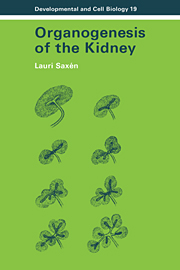Book contents
4 - Experimental tubulogenesis
Published online by Cambridge University Press: 22 October 2009
Summary
Introduction
Chapter 1 described the major features of the early organogenesis of the vertebrate excretory system and the complex, yet synchronous, development of the various cell lineages involved. A detailed analysis of these various events and their causal relationships requires an experimental approach in which the prolonged, multiphasic organogenesis is dissociated into single – or at least less complex – processes for more detailed exploration. Chapter 2 listed many such techniques and model-systems including cultivation of nephric tissues and their subfragments in vitro, various culture methods for kidney-derived cell lineages, and grafting of nephric material onto heterotopic sites such as avian chorioallantoic membrane. Probably the most advantageous technique is still the one devised by Grobstein (1956a, 1957), who utilized thin membrane filters. As described in detail on pp. 48-50, the transfilter technique involves an experimental triggering of the responding nephric mesenchyme towards epithelial direction, ultimately leading to the formation of nephric tubules. By this strictly controllable technique the differentiation of the determined target cells can be followed at molecular, cellular, and tissue levels. The events can be temporally correlated, which may allow us to draw conclusions as to their causal relationships. Consequently, Chapter 4 will be devoted to observations of cultured and experimentally induced metanephric mesenchyme. In addition to the advantage of exact timing, this technique and the corresponding model-system offer an adequate control tissue: a separated metanephric mesenchyme identically treated and cultivated but not exposed to an inductor is a proper control for most experimental situations. Needless to say, like all systems in vitro, the transfilter model-system is susceptible to many artifacts and does not necessarily mimic development in vivo.
- Type
- Chapter
- Information
- Organogenesis of the Kidney , pp. 88 - 128Publisher: Cambridge University PressPrint publication year: 1987
- 2
- Cited by



